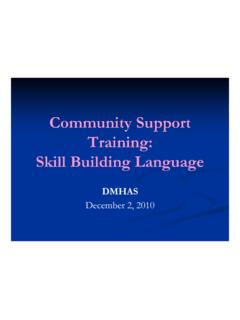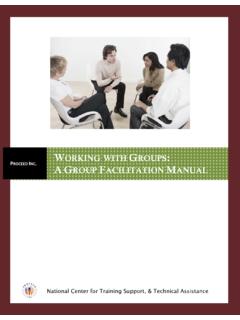Transcription of Developing good practice in Connexions: …
1 Connexions National Evaluation and Research StrategyDeveloping good practice in Connexions: Techniques and Tools for Working with Young People ContentsAcknowledgementsi1 Introduction1 Background to the guide 1 Current use of techniques and tools in Connexions 1 Purpose of the guide 2 What are techniques and tools? 3 Assessment and the APIR 3 Why are techniques and tools needed? 3 Can techniques and tools be harmful? 4 How effective are they? 52 Getting off the ground 7 Preparing yourself7 Establishing a PA-client relationship8 Introductions and setting ground rules9 Showing respect9 The environment10 Confidentiality10 Length of the period of contact113 Basic counselling techniques12 Acceptance and empathy12 Praise and encouragement13 Active listening13 Reflective listening14 Asking open-ended questions14 Cultural sensitivity154 Helping PAs to be more effective16 Training16 Supervision of PAs18 Disclosure and making referrals19 Evaluation and measuring outcomes19 Hard and soft outcomes20 Distance travelled21 Attribution215 Techniques and tools22 Introduction22 Cognitive Behavioural Therapy23 Solution-Focused Brief Therapy26 Neuro-Linguistic Programming (NLP)
2 29 HARP 31 motivational interviewing32 The Rickter Scale 346 Other techniques and tools37 Success Ladders and the Connexions Adviser Training Pack37 The Salt Pot39 Making a time-line 40 Bio-feedback41 Life-coaching42 Group work437 Bibliography45 Websites explaining techniques and tools45 Books, reports and articles457 TablesTable 1 A technique used within CBT25 Table 2 Some solution-focused techniques28 Table 3 Components of NLP29 Acknowledgements This guide to Developing good practice was the idea of MartinPatrick of The Humberside Partnership. With colleagues atConnexions Humber he explored the potential of a range oftechniques and tools during the pilot phase of Connexions. Thisproject is a development of that work. His invaluable contribution at all stages of the research is acknowledged with many thanks.
3 We are grateful to the Connexions Service National Unit for funding the research and particularly to Derren Payton, projectmanager. Additional funding was provided by Connexions Humberand the Humberside Partnership, and we are grateful for theirgenerous support. We would like to thank the ConnexionsPartnerships and PAs who took part in the research and especiallythe managers who hosted visits and arranged discussions with are Paul Wilkinson (Cheshire and Warrington), Susan Spoors(County Durham), Judith Cook (Cornwall and Devon) and AngelaHill (South London). Heather RolfeMay 2003i11 IntroductionThe techniques and tools covered in this guide are for use in interventionswith young people, usually following or alongside assessment using theConnexions Framework for Assessment, Planning, Implementation andReview (APIR). They are distinct from assessment tools in that they areintended not to measure skills or abilities but for personal development andto improve an individual s capacity to bring about change1.
4 They are alsodistinct from psychotherapy or counselling aimed at exploring problems andtheir underlying causes. They have been usefully described as communicationtechniques (Barker and Irving, 2001) and are derived from counsellingapproaches, such as Cognitive Behavioural Therapy (CBT). Background to the guide The need for Connexions Partnerships to find new ways of assisting young peopleexperiencing barriers to progression or in danger of dropping out was recognised at anearly stage in the development of Connexions. During the pilot phase of Connexions, TheHumberside Partnership explored the potential of a range of techniques and tools forworking with young people, derived from counselling. These were assembled into a toolkit designed to support the work of Personal Advisers (PAs) and others deliveringservices within Connexions. The toolkit, available on the Partnership s Website( ) reviews and evaluates tools and approaches that have beenidentified as potentially useful in helping individuals to move forward.
5 As Connexionsdeveloped into a full service Martin Patrick, who led the toolkit project for TheHumberside Partnership, identified a need to conduct research on techniques and toolswithin Connexions. The idea was that this should establish current usage of techniques,levels of training, the potential for further development and issues relating to practice . Thisguide is the result of that idea. It is aimed at helping Partnerships and PAs to be moreeffective in their interventions with young people and to achieve better outcomes,particularly with young people in the priority group2. Current use of techniques and tools in Connexions The research began with a survey of all 28 Phase 1 and 2 Partnerships to establish baselineinformation on the current usage of techniques and tools within Connexions. Theirresponses strongly indicated that this is an area under development within the service buthas already got off to a strong start3: of the 23 Partnerships who responded, all but onewere using at least one of the following approaches: motivational interviewing Neuro-Linguistic Programming1 The distinction is, however, not clear since some techniques aimed at personal development include assessment as a means of identifying issues and measuring change in attitude.
6 2 These are young people not in education, employment or training (NEETs) and potential NEETs irrespective of ability or circumstances. 3 This is partly because many careers services began to introduce techniques and tools following the DfEE policy, from1998, to focus the delivery of guidance services more directly on need and particularly to address disaffection, lowaspiration, low achievement unsuccessful progression to learning beyond age 16. Brief (or Solution Focused) Therapy Cognitive Behavioural Therapy The Rickter Scale Of these, motivational interviewing , Neuro-Linguistic Programming and the Rickter Scalewere most widely used, adopted by more than half of the Partnerships. Eleven of thePartnerships were using three or more approaches. The background research confirmedthat Connexions Partnerships perceive a need for techniques and tools for use with youngpeople, particularly with individuals requiring intensive support because of barriers toparticipation, learning or progression.
7 In discussions with Partnerships it was apparent that many were experimenting withparticular techniques and tools, through trials of training, piloting and evaluation, beforedeciding which to adopt as standard practice . One manager described this as decidingwhich horse to back . A number of Partnerships had gone a stage further and weredeveloping their own approach to working with young people combining variousapproaches. Purpose of the guideThe guide is intended to assist Connexions Partnerships, managers and PAs to developgood practice in working with young people. This includes deciding which techniques to introduce and the training necessary for PAs. It is aimed at the following: The standard PA, not those working as specialists who will require more in-depthtraining and practice in counselling For use in face to face contact with young people (although some of the techniques areequally applicable for telephone contact) For use principally with young people (although some techniques may also be usefulwith parents and other adults) Although many of the techniques and tools described in the guide are derived fromcounselling, PAs are not counsellors, with the exception of specialist PAs trained in suchareas as drugs and alcohol counselling.
8 The role of the Connexions PA is not to findsolutions to young people s problems but more specifically to address disaffection andunder-achievement and to increase participation in education, employment and this will often include intensive support, PAs should not adopt the role ofcounsellor and to help find solutions to personal problems, for example drug misuse ormental health problems. They must be careful not to take on this role, and when theybecome aware of serious and deep-seated problems, refer a young person to a specialistPA or an appropriate agency. 23 What are techniques and tools ?In explaining the approaches included in this guide two distinctions should be made: firstbetween psychological assessment in the form of psychometric tests; and second betweenassessment and intervention. On the first of these, the approaches included in this guidecould be described as communication techniques (see above) and are derived fromtheories of counselling.
9 They are distinct from psychological assessment which aims toassess ability, aptitude and skills, typically off-the-shelf psychometric tests. These haveformed the basis of much assessment in careers guidance for many years and will continueto play an important role in assisting career decisions. However, when working withdisaffected or disengaged young people, PAs may need to give greater emphasis tomotivational issues and attitude. This includes enabling a young person to become moreaware of their thoughts and attitudes which present barriers to participation andprogression, rather than focusing on what qualifications or skills they might need to followcertain paths. Such work requires particular skills on the part of the PA, particularly ininteracting with young people to help them to identify their thoughts, beliefs andattitudes. To do this effectively requires an understanding of how techniques and tools canwork, and this involves a basic understanding of their theoretical grounding.
10 This isexplained within the guide. Assessment and the APIR The emphasis of this guide is on interventions with young people. Some of the techniquesalso include assessment by the client, usually to measure progress made by theintervention. Sometimes the distinction between assessment and intervention is not clear,particularly where the client takes a very active role in assessment and, in so doing,identifies barriers and possible solutions. The key tool for assessment within Connexions isthe Framework for Assessment, Planning, Implementation and Review (APIR). Its aim is toconsider a young person s strengths and needs across a wide range of factors which maybe relevant to their transition, including education and employment, social and personaldevelopments, family and environment and personal health. It includes creating an assessment profile , a visual summary of a young person s situation, Developing a personalaction plan and associated monitoring and recording.














